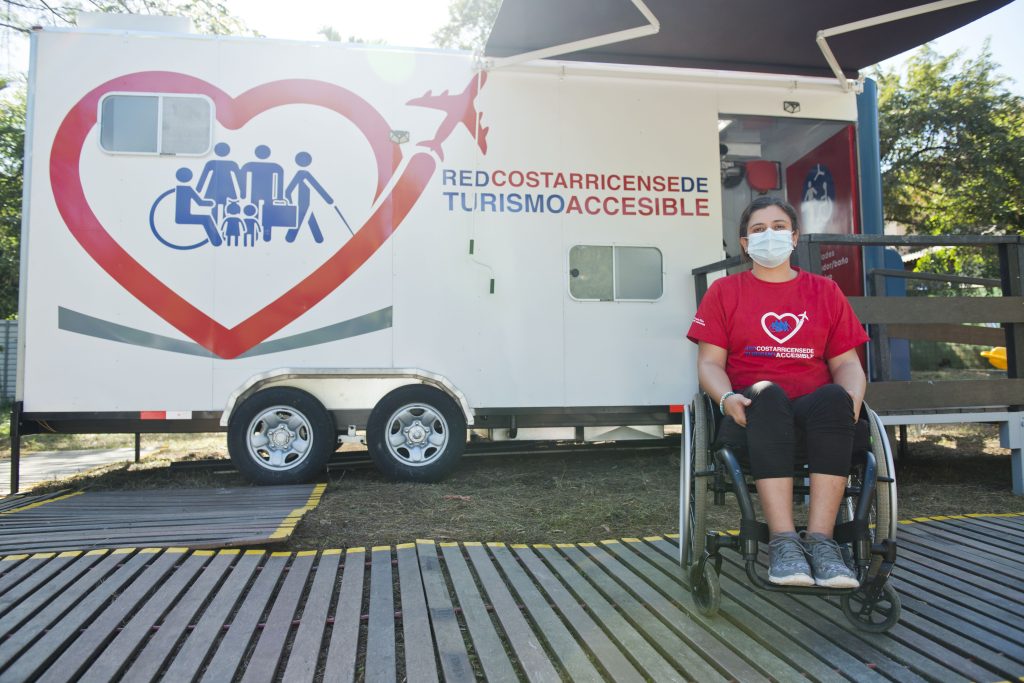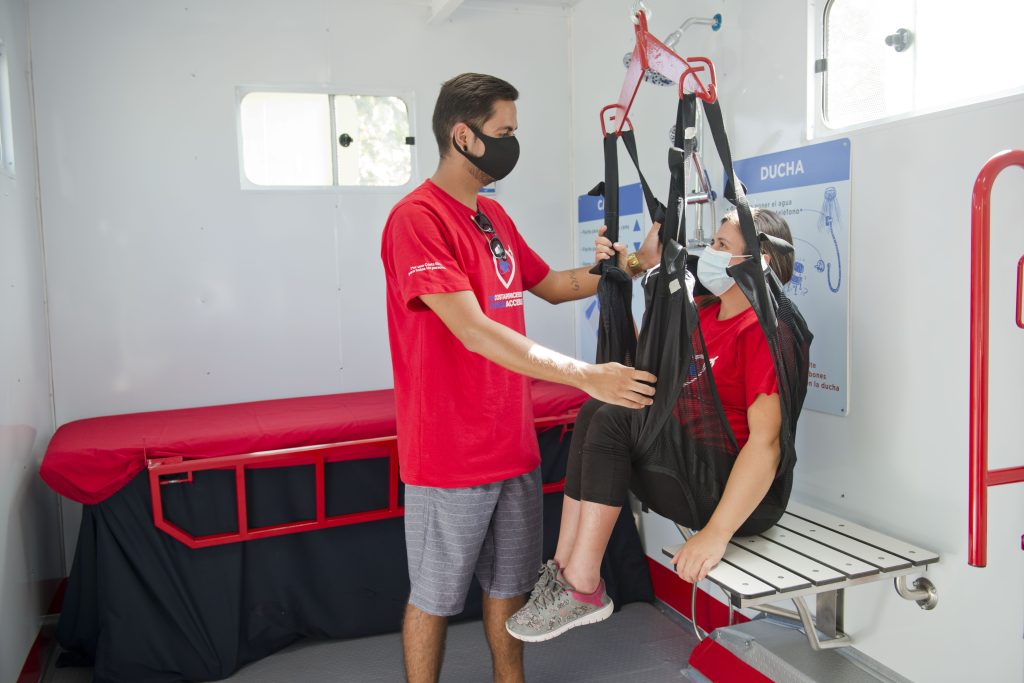When Derek saw Costa Rica’s first accessible beach, Jacó, he knew what to do. Immediately. He’d been waiting a long time.
“He went into the sea right away, without even thinking, in his electric wheelchair,” says Stephanie Sheehy. “Of course, he destroyed the wheelchair!” The travel leader recounts that the Dutch visitor and his team then had to source replacement parts from England. It was costly, complicated, and well worth it: “It had been 20 years since he’d touched the sea.”
Stephanie and her husband, Emilio Zúñiga, co-founded Il Viaggio Travel in Costa Rica 18 years ago, and stumbled onto the niche of accessible travel through chance, she explains. In 2008, a European traveler who uses a wheelchair asked them to put together an accessible itinerary. After a successful first visit, the client started returning to Costa Rica with Il Viaggio each year, and the co-founders wondered how many other travelers might need similar services.
Stephanie and Emilio studied the terrain carefully, she says, and were surprised to learn that “15% of the world population has some type of disability, and 20% [of travelers] are senior citizens who need some type of assistance… we spent five years analyzing Costa Rican tourism providers.”
Convinced they could address a significant demand, Il Viaggio started bringing travelers with severe disabilities to Costa Rica in 2016 and, over the years, has amassed experience, contacts, and equipment to facilitate “universal access” for any traveler. However, he agency quickly realized that to make a real impact on accessibility in Costa Rican travel, it would need a platform bigger than just one company.
In 2017, Stephanie and Emilio founded the nonprofit Costa Rican Accessible Tourism Network to unite public and private actors around this issue. Today, they work with the Costa Rican Tourism Institute (ICT), National Training Institute (INA) and other public entities to inform and educate on accessibility issues, although Network’s work is privately funded by 2% of Il Viaggio’s tour income and by its Donatapa bottlecap collection initiative.
Stephanie offers a few key ideas for travelers seeking to ensure their visit to Costa Rica is accessible for everyone in their party, and for travel providers as well.

1. Be aware that Costa Rica provides more access than many—but nowhere near enough.
If you know the number of any Costa Rican law by heart, it’s probably 7600—the Law of Equal Opportunities for People with Disabilities, which took effect in 1996. Many in Costa Rica (including this writer, before talking with Stephanie) think that if a business ticks the boxes of this legislation, such as installing ramps and ensuring disabled parking, it is ready to host a wide variety of travelers with diverse accessibility needs.
Not so, Stephanie says.
“Costa Rica has a serious problem: it’s called Law 7600,” she says. She adds that while it’s of course a major advantage that Costa Rica has the only disability law of its kind in Latin America, the law also causes business owners to assume that the law’s requirements are enough. That’s where they stop.
According to Stephanie, if you are a traveler looking for “basic accessibility”—in essence, secure walking access with supports such as guardrails and anti-slip flooring—then a business that complies with Law 7600 will be sufficient for you. But for more significant disabilities, the gaps in the law and its application mean that there’s no guarantee the hotel room made accessible by a ramp will also have an accessible bathroom, with the proper door width, sink placement and other essentials. Things such as ramp placement and quantity are often decided by architects and reviewed by Health Ministry officials, neither of whom have specialized training in accessibility to allow them to evaluate these components in a rigorous way, Stephanie says.
“In Costa Rica a truly accessible room, I have maybe three hotels in the entire country,” she adds. “All the rest are poorly done.” (Travelers can consult a list of accessible facilities on the Network’s homepage.) She differentiates between basic accessibility and “universal accessibility,” which means that any traveler—for example, a traveler with quadriplegia as opposed to a wheelchair user with upper body strength and mobility—can use it fully.

2. Look for a travel agent that guarantees accessibility—or a local provider with expertise and equipment.
What to do? Stephanie says that even for travelers who need only basic accessibility (again, that could be any traveler who needs to avoid stairs or needs a guardrail), it’s not enough to look for an agency or tour operator that mentions accessibility or displays a wheelchair logo. Travelers must ask whether that agency guarantees accessibility as part of the package.
That means that, for example, a traveler who books a hotel’s one accessible room won’t be told upon arrival that that room is not available.
For travelers who need more extensive support, it’s essential to ask if local providers have experience and the necessary equipment, such as patient transfer devices and amphibious wheelchairs, Stephanie says.

3. Travelers: your advocacy is essential. Travel providers: step it up.
Stephanie says that, without a doubt, the travelers with disabilities who visit Costa Rica open many doors—not only for other travelers, but also for Costa Ricans who benefit from a more accessible and inclusive society.
She points to the “universal changing rooms” that the Accessible Tourism Network and its partners have set up at Costa Rican beaches as one example. The facilities include transfer devices so that caregivers for people with cerebral paralysis, for example—who generally, in Costa Rica and other places in the world, have to put down a plastic tarp in a regular bathroom to change the person on the floor—can transfer the person to an accessible bed and change the person “with dignity.” Such facilities open doors for travelers and Costa Rican families alike, she says.
While the many Costa Rican trips she, Il Viaggio, and the Network have facilitated over the years have included many learning experiences and tough moments, Stephanie says that sometimes those setbacks are what lead to growth.
“One trip was totally accessible and reached Monteverde, the only accessible room” in town, she says. She says the traveler had quadriplegia and traveled with a transfer device that wouldn’t fit into the room, and the bathroom door was too narrow to admit the wheelchair. As a result, the traveler could neither lie down in bed, nor enter the bathroom.
According to Stephanie, her first step in these situations is to get the hotel owner into the room to see exactly what the obstacles are, because that’s how change happens: “The impact and shame make this [process] stronger.”

We are grateful for the support of Travel with Ann Experiential for the travel content in our January and February editions. Ann Becker has been a small business owner throughout her career. With more than three decades of experience in meeting/event management and strategy consulting combined with a passion for travel rooted in deep, mutually beneficial human encounters, in 2005 she began Travel with Ann Costa Rica. For 15 years she created and led more than 40 small group experiential trips in Costa Rica, neighboring countries, and Chile. Today, through Travel with Ann Experiential , Ann is dedicated to supporting and strengthening responsible travel small businesses, nonprofit organizations and industry leaders by forging strategic connections; contributing fresh perspectives; engaging and elevating diverse voices; and strengthening organizational capacity.







